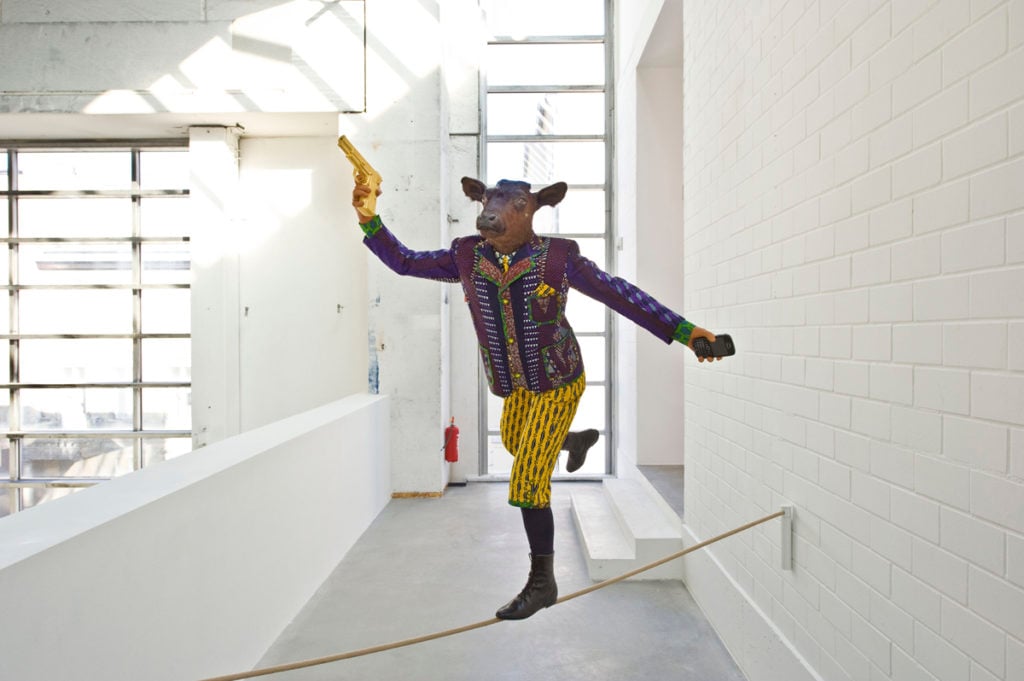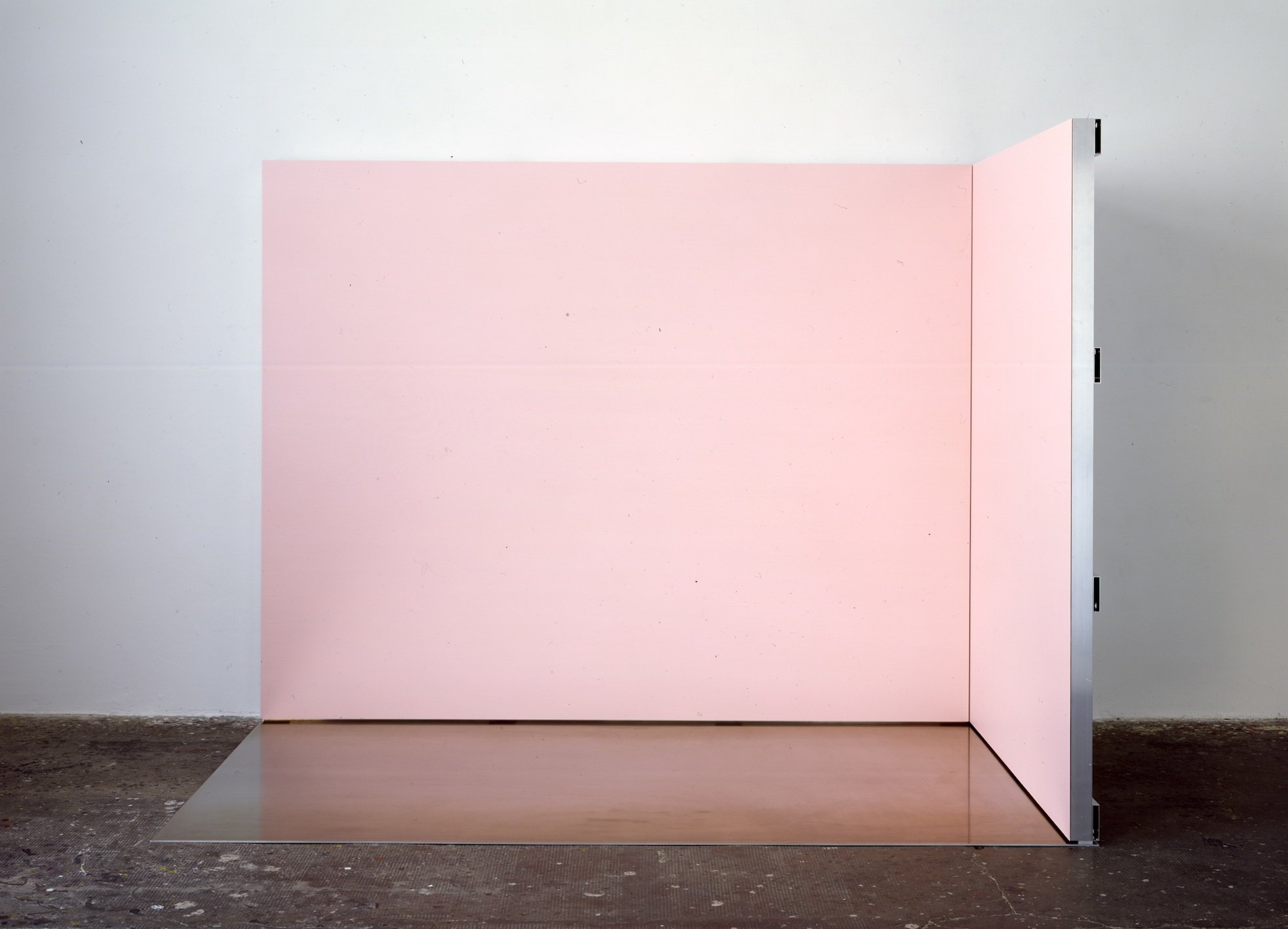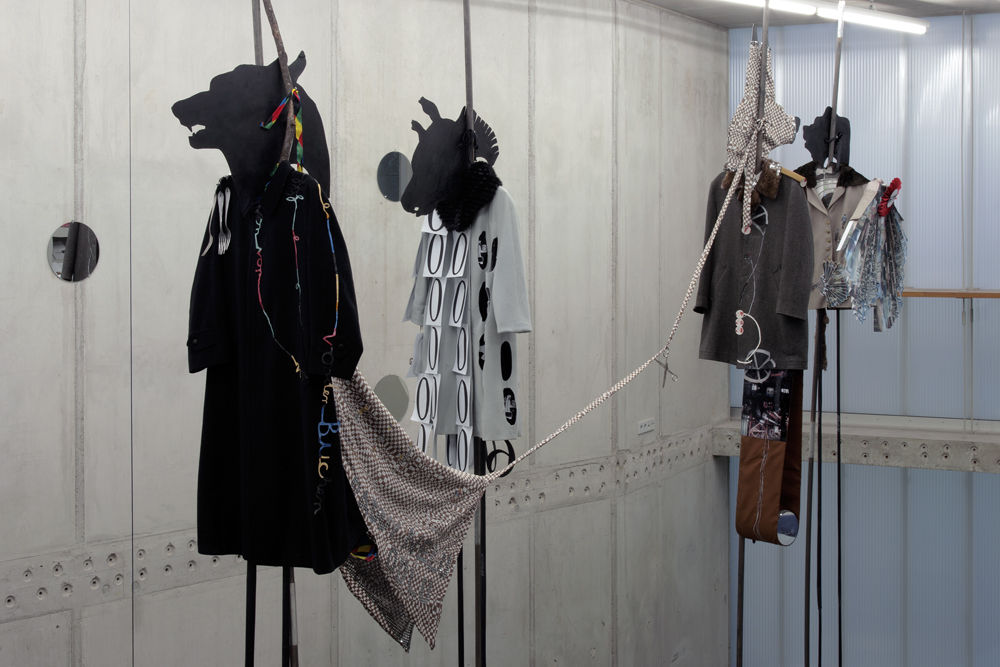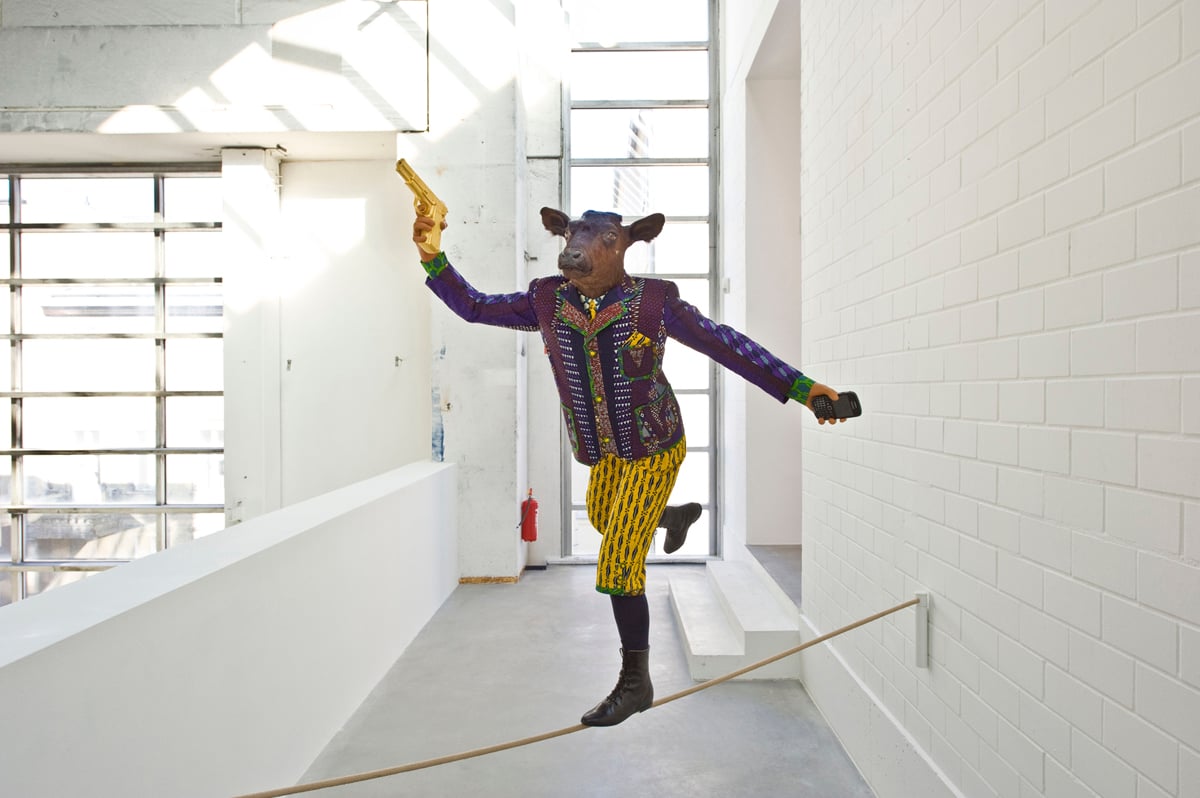Art & Exhibitions
In Review: Berlin’s Must-See Gallery Shows This March, from John Bock to Monika Sosnowska
Sprüth Magers, KOW, Blain Southern, and others have stand-out exhibitions this month.

Sprüth Magers, KOW, Blain Southern, and others have stand-out exhibitions this month.


John Bock, “Knick-Falte in der Schädeldecke”
Photo © Alexander Forbes
John Bock, “Knick-Falte in der Schädeldecke,” Sprüth Magers
There’s an oft bandied-about saying that Sprüth Magers is Berlin’s Kunsthalle. Never has that been more accurate than during the gallery’s first John Bock exhibition. The show opens with a rather demure amuse-bouche: a wall of messy sketches on the right—Pole Poppenspäler (2010-2014)—and, in the far quadrant of the space, an odd little anthropomorphic sculpture made from a cardboard box and two buckets stacked atop one another, what look to be broom handles painted in stripes for arms and legs, and a stuffed sweater sleeve for a head. Uncanny, yes, but it’s not even close to adequate prep for what’s to come.
Entering the gallery’s main hall, blacked out entirely on this occasion, you are thrown into a version of Bock’s set for the exhibition’s central film work, Unzone Eierloch (2014). That 48-minute loop plays in the far corner and takes the viewer from a not-so-distant reality—a teacher figure lectures two younger protagonists through a chain fence in some darkened industrial setting—to dream sequences, which see noir-style shots of a topless, dominant female character performing vaguely scientific-looking rituals and slaughtering and dissecting a humanoid figure. On the opposite side of the space, a series of flatscreen monitors dives deeper into each of the five dream sequences.
The set-cum-installation itself is a masterpiece and steals the show. It brings together a mad range of found objects—squashed cans of egg-filled ravioli and other foodstuffs, children’s clothes and blankets, paintings, lamps, a hospital curtain, and a bike wheel—with sculptural elements distinctly reminiscent of Franz West. The installation is immersive; one can easily loose a half hour searching through its detritus to unpack its creator’s pathologies and end up nowhere. Curators stumped to fill a fall or spring slot: Just hit cut and paste.
Through April 12.

Imi Knoebel, Ort-Rosa (2013).
Courtesy Kewenig.
Imi Knoebel, “Rosa Ort,” Kewenig
If Sprüth Magers is a Kunsthalle, Kewenig is aiming toward museum status with their latest show of legendary German artist Imi Knoebel. Twelve works—11 wall pieces and one sculpture—grace the gallery’s first floor for the show and continue Knoebel’s minimalist investigation of form, color, and space. All but one are from the past year.
The exhibition’s titular piece, Ort – Rosa (2013), is a room-like space created when two Pepto Bismol-pink walls meet in a corner, an aluminum sheet providing a highly reflective floor off of which their color reverberates. Like the best minimalist monochromes, the piece is synesthesia-inducing. The sensation becomes amplified when you enter the work, thanks to its three-dimensional form. One not only feels pink, but, because of the reflections, your internal white balance shifts to a new, rosy reality.
The wall-based works on view are also increasingly spatial in nature. Several, like Bild 06.10.2013 (2013), employ barely-iridescent paint on one of their acrylic-painted aluminum elements. In this case, the more amoebic of two parts shifts from that same pink to white to light green while its squared-off counterpart remains flatly white. So subtle is the shift, however, that it first appears as a mere momentary glint in one’s peripheral vision. The work grabs attention and holds on tight.
Through April 26.

Installation View, Alice Creischer, “In the Stomach of the Predators,” KOW Berlin.
Courtesy KOW Berlin.
Alice Creischer, “In the Stomach of the Predators,” KOW
What happens when late capitalism’s grow-or-die vector runs out of commercial space through which to travel? It makes more, says Creischer, whose second exhibition with KOW focuses on the dissolution of the commons into the sphere of private profits. For the show—both a jumping off from her previous effort during Gallery Weekend 2012 and a further maturation of her art’s vocabulary—Creischer has developed four different characters, each representing a different order of capitalist predator: the wolf, the hyena, the bear, and the jackal.
Each stands in effigy, high on stilts within the gallery’s upstairs space. The animals’ wooden silhouettes sit atop two over-sized T-shirts, a riding coat, and a car coat, respectively, with varied knick-knacks of indecipherable significance pinned to or dangling from their bodiless figures. Creischer deploys a humor in her characters’ sculptural presentation as well as in their actions when embodied by her children and those of fellow artist Andreas Siekmann in a video, In the Stomach of the Predators (2012/2013), shown downstairs. (Siekmann has a concurrent show at Galerie Barbara Weiss that continues the pair’s oeuvre.)
Wearing the predators’ wooden heads, the children bound about, allegorically distributing genetically modified, biodiversity-crushing seeds from Spitsbergen (the wolf), privatizing public lands in Benin (the hyena), displacing populations from socially diverse neighborhoods in Istanbul (the bear), and damaging the global ecosystem for profit (the jackal). Wrapped up in a happy, children’s-book-like package, the activities and actors look harmless, even banal. But slip on a pair of the provided surgical gloves and flip through postcards of each animal’s destruction and you realize they’ve already made good on their fable’s threat.
Through April 19.

Yinka Shonibare, MBE, Revolution Kid (Calf) (2012).
Photo: Christian Glaeser, 2014. © the artist, courtesy the artist and Blain|Southern.
Yinka Shonibare MBE, “Making Eden,” Blain Southern
Shonibare’s first solo show in Berlin sets a welcome, colorful, and visually rich counterpoint to much of what goes on in this city. But in terms of subject matter, the show is far from light-hearted. Shonibare lauds revolution’s positive potential, while decrying its often-chaotic wake and interim human cost. Split in two halves, the show inverts heaven and hell.
Downstairs, in Blain Southern’s sprawling main hall, just three works are on view. They create a supposed “Eden” of revolutionary potential. In Adam and Eve (2013), two mannequins dressed in African textiles appear frozen mid-dance, Eve holding an apple whilst a snake hangs above, poised to strike. With the biblical imagery, Shonibare says he wanted to employ a sort of least-common-denominator—but the cloth itself is potentially more revealing. Although it employs motifs popularized in Africa as a sign of independence in the 1960s, this Batik fabric is made in the Netherlands and sold in the UK. It thus offers only a façade of authenticity, much like Shonibare’s utopian vision of new beginnings. Spanning the downstairs space’s main wall, Eden Painting (2013) offers a similarly skin-deep quotient of hope for a rethinking of anthropocentric resource consumption. Toy figurines of animals from Noah’s Ark surround each of the wall sculpture’s 75 circular panels, which have been covered in further Batik textiles and are affixed directly to the large sky-blue rectangle painted of the wall. The work’s almost cutesy presentation gives an impression that such a shift will wither under a realist’s gaze.
That realist would feel well at home in the gallery’s dystopic mezzanine, its tone set by a single work: Revolution Kid (Calf) (2013). Posed after Delacroix’s ever-popular touchpoint Liberty Leading the People (1830), a boy with a calf’s head wields a replica of Colonel Gaddafi’s golden handgun in one hand and a Blackberry in the other. The message? Revolutions and revolutionaries may come and go, some lauded, some watched in horror, but the cycle of violence persists and over time the fruits of idealistic rebels and hardened dictators look equally rotten.
Through April 19.

Installation view Monika Sosnowska, Stairway (2010).
Photo: Jens Ziehe, © the artist, Courtesy Capitain Petzel, Berlin.
Monika Sosnowska , “Stairway,” Capitain Petzel
The latest presentation of Sosnowska’s 2010 installation, Stairway, is something of a reversal of the Warsaw-based artist’s central trope: art’s influence on architectural spaces. Created for her show at the Herzliya Museum of Contemporary Art in Israel, the piece sees a recreation of a since-removed emergency spiral staircase from the Museum of History of Tel Aviv crunched—or, in other subsequent presentations, elongated—and twisted to fit each given locale.
In Herzliya, it looked as if the museum’s white cube was compressing the object, adding air pressure to the space. At the K21, a similar staircase (though technically a different work) was sent hurtling off of a balcony to cascade down five stories, made to look infinite in its irregular spiral. At Capitain Petzel, thanks to the walkway suspended along the gallery’s back wall and its bank of windows on the wall opposite, the installation becomes much more sculptural in orientation and almost looks misplaced.
Without the crunch of a white cube or airy expanse of a Kunsthalle, focus shifts from room to object. The eye grasps not Stairway’s architectonic effects but the rubbery-looking surface of its painted metal, the delicate ripples in the tubing where major bends occur, the fluid interplay of the railing’s supports. Once totalitarian in its effect (and initial reference to now-crumbled strongmen from the eastern block), the work becomes playful and, dare I say, pleasingly poetic.
Through April 19.